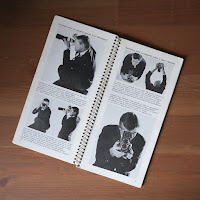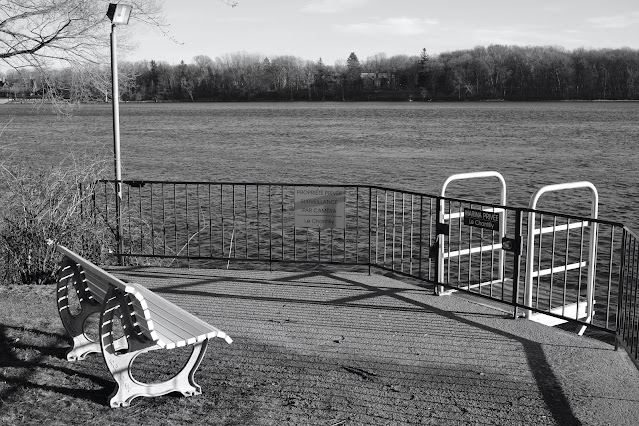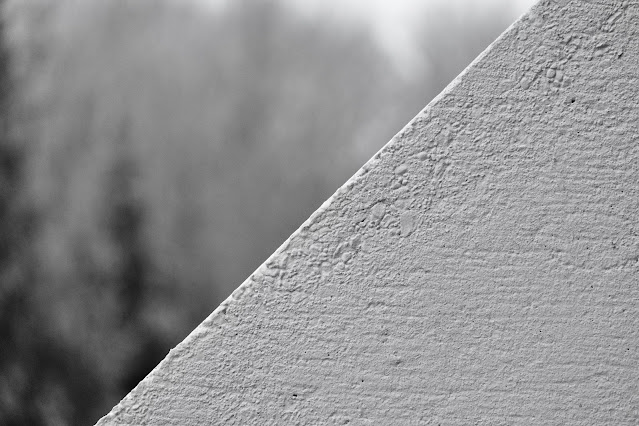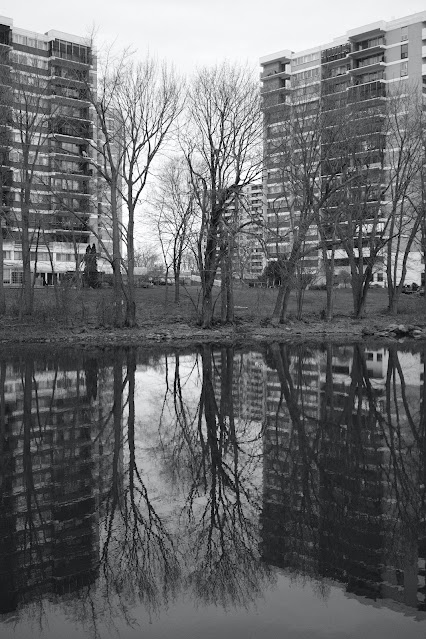This is a second time that I give a try to the Fujifilm X-E4 model although the first essay didn't last very long (few days at the most). I have to confess that I had a long love affair with the previous
Fujifilm X-E3 camera which I have considered as an outstanding evolution from the preceding
X-E2S/
X-E2/X-E1 models. So, a crude direct comparison at the time was almost impossible because the new Fuji X-E4 interface/design is so differing from the X-E3 one.
The Fujifilm X-E4 is a real compact rangefinder style (off-center viewfinder from the lens) APS-C format digital camera. It can be compare in size and in weight to the Fujifilm compact X100 series although the 23mm lens of the latter must be substitute by the Fujinon XF27mm with a lens maximum aperture variation (F2.8 versus F2). If the Fuji X100 series benefit of their hybrid viewfinder (optical + electronic) the X-E series have the advantage of lens interchangeability that confer them a greater versatility.
One of the first important thing to remark about the Fujifilm X-E4 is its complete ability to be use completely manually in term of exposure and focusing parameters. Starting to this traditional way of setting the X-E4, you can gradually introduce a progressive automation. Except for the image sensor sensibility (ISO), the shutter speed and the aperture can be preselected visually without looking at the electronic viewfinder (EVF) or to the LCD back screen or live monitor (LVF).
The OLED 2.39 Mega dots electronic viewfinder resolution should be sufficient for the photographic composition purposes and for the visual focusing tasks but we have to admit that its definition is now surpassed by some new camera models. Its 17.5mm eye point is also quite short for the eyeglass wearers but we can accommodate ourselves to use it properly. The tilting (up & down) back screen (LVF, live viewfinder), with a "selfie" option that some may questionnaire its real utility, is excellent to preview and review our picture as for navigating into the camera settings and the menu. All the camera informations are clearly visible through the EVF and LVF and can autorotate to accommodate vertical composition.

The Fujifilm X-E4 control dials and function buttons as for the joystick are rather small in regards of larger sized cameras but it is often the price to pay for a more compact camera in particular if you don't want that these selectors interfere too much to the compact camera hand held which is already minimalist with the X-E4. As it appears like a mimic of a Leica M camera body design, you cannot anticipate to have a protuberant grip available on front of the Fuji X-E4. As it is usual now, there are some optional hand grip and thumb rest accessories that are available for those who need them but they may induce a more difficult access of some options on the camera (hot-shoe, battery/memory card fast access). On another side, the Fujifilm X-E4 will slip easily into a larger coat pocket or a small shoulder/messenger bag. Moreover the small weight of the camera permit you to attached it on a shoulder strap et let it around your neck without too much discomfort.
In term of picture file quality, the 26.1MP APS-C image sensor will give the same resolution already offered by the larger Fujifilm models such as the X-Pro 3, X-T3, X-T4 and X-S10. Providing you are using the same taking lenses and the same exposure parameter settings, no differences should be noticeable. This is one of the big advantage to use different Fujifilm models from their X-mount line without loosing image definition.
No IBIS (Internal Body Image Stabilization) and for the strong supporters of this modern camera feature, it is (again) a disappointment. Low light situations will ask you to be more attentive to the stability of the Fuji X-E4 and avoid slow shutter speeds that you cannot handle efficiently by using a tripod or a good support (as we use to do during the analog-film era). For the travelers in life, zoom and fix focal lenses with an optical stabilized (OIS) may be a better choice even though the optic will be larger size and heavier.

Navigating through the Fuji X-E4 menu system demonstrates its inherent versatility when you are interested to do so. You can also satisfy yourself by enjoying its simplicity by using the Fujifilm X-E4 default configuration and it will answer the most common photographer needs or, if you want, you can go deeply by selecting through all the options available and refit the camera to your own tastes. My only advice is to try and analyze these functionalities one at the time and, if necessary, to register them by using the custom modes (via Menu and custom setting: C1/C2/C3/C4/C5/C6/C7).
The Fujifilm X-E4 doesn't have the same facility to get a rapid access to functionalities such as the film simulations, the drive options and the exposure metering modes, the image sensor sensibility(ISO) and focusing settings, the custom ones, etc without using the menu, the quick menu (Q) and the touch screen functionality algorithms, as it can be done with the direct control dials or function buttons present on the larger size Fujifilm models. For on the spot requirements, the camera setting variations are far less spontaneous in profit of a more automated system you may rely on. The photographer creative part is more concentrate to his/her photographic picture composition and the chosen photographic moment. You are still able to select specific picture setting bias but with a more "presetting" approach. However the two schools (X-E4 and X-T/S series) can deliver an original signature imagery specific to its author.
If a big concern when using the Fujifilm X-E4 is how you can create customized configurations and to get access to them in a rapid and reliable efficient way as, for example, if you want to permute from a standard automatic exposure and focusing program setting to a fast focus tracking and spot metering action subject or if you want to do manual photography in a monochrome film simulation, you may follow my modest example. After struggling a bit at first (without looking the instruction virtual operating manual), I was able to create these configurations and to set them easily through the Q menu. The limit number of custom configurations has been fixed by the manufacturer to 7 which seems to be enough if you can remember all them! You can rename them for more comprehensive references. With these pre-arranged customized settings, the Fujifilm X-E4 will become not only a versatile digital camera but also a more competent one.
The fujifilm X-E4 is surely a nice piece of engineering that will deliver stellar picture results and don’t be fooled by its simplistic interface (not a lot of direct control dials and function buttons) because as it was my case at first, the more you get habit to use it, the more you will develop respect for its capacities.
Film simulations and Advanced filters.
One big reason to adopt the Fujifilm X-mounts series is surely their color and monochrome film simulation science that is present into the entire line of X-mount camera models. Although using RAW image file base is the finest way to get the maximum latitude to fine tune your final picture, Fujifilm JPEG film simulations are reproducing with great success all the expertise that have develop during their legendary analog-film era. This (Film simulation) setting advantage has been mentioned several times by the various photo gear reviewers over the Web and more importantly by the Fujifilm camera users themselves.
Fujifilm film simulations are very creative color and monochrome tone palettes that allow the photographer to select different and rich atmosphere signatures. Remember that many analog-film era professionals or amateurs used to choose certain type of films to get the image final effect they were looking for. Today these choices are now not only available through digital recording but can be permuted on the spot without any trouble process. No more need to own different negatives or slide films, no need to change film cartridges or have on hand different camera bodies, It is simply liberating in so many photo taking aspects.
Viewing the final result before taking it!
This is definitively another huge advantage of the mirror less camera category with a competent electronic viewfinder (EVF) or a fine LCD back screen (LVF). We came from a very long way to get that magic feature especially for those who have worked with the analog-film previous technology. The Fujifilm X-E4 may not have the latest EVF or LVF specifications available but the ones they have installed are largely sufficient to help the photographer in its imaging-exposure settings and its focusing adjustments.
Just turn the (control) dials!
Just turn the control dials from their respective “A” position and you will ether select the shutter speed or the aperture you want. To get a fully manual settings, just press the front push button to select the image sensor sensibility (ISO) you will prefer and put the focus in manual through the quick menu, or better than that, simply create a Custom setting with all these bias. In this fully manually controlled approach, the EVF or the LVF will show precisely the effect of your selected parameters.
Spontaneous, discrete, amateur look
Although many photographers prefer to work with bigger size cameras that may help them to get credibility and attention, some others are preferring to better work "behind the scene" and, in doing so, to appear less intimidating in front of their subjects. The Fujifilm X-E4 is a discrete photo device not only in size dimension but also in its operating mode especially with you are electing to activate the electronic shutter option (ES). With this approach, spontaneous photography (street, travel, visual) is easy to perform. Even with its more "amateur" look, most people won't pay attention to the potential serious aspect of photographing and the Fuji X-E4 can give to the photographer an amusing touristic look.
Commented bits
No internal electronic flash has been incorporated to the Fujifilm X-E4. This useful option had already disappeared with the Fuji X-E3 previous model. Therefore you will need at least a small flash unit to bring with you if you have the intention to do some fill-flash photographs. Furthermore, Fuji is no more furnishing an external one with the X-E4 as it was in the past for the previous
X-E3 with the EF-X8.
The Fuji NP-W126S dedicated battery pack is the unit that is required by the X-E4. It is the same unit present in many other Fujifilm X-Mount digital camera models (with the exception of the more recents with higher price). Common to the newest camera model introductions, no battery charger is furnished by the manufacturer but the camera is doted of the newest USB-C port that allows a faster battery charge that can be available through your different accessory USB-C ports from your computer or mobile devices or chargers.
The none lens centered tripod accessory screw mount hole of the Fujifilm X-E4 doesn't have my preference to work with a tripod or monopod combination. Yes, that can be counteracted by using a screw mount tripod accessory plate or by adding an accessory grip w/integrated Arca-Swiss type bottom plate but it will also add to the bulk of the camera body.
About the construction quality of the Fujifilm X-E4, you may find that it is similar to what you can already observe to the others Fujifilm models like those from the X-T10/20/30 series for example. The Fuji X-E4 is not qualified as a weather resistant (WR) camera body and precautions must be taken when you are expecting to expose it into adverse conditions. At this moment of time, no report have been stated that the Fuji X-E4 is more fragile or more prompt to cease operation under climatic stronger variations (cold, humidity, altitude) but gradual acclimation is always a good recommendation.
If you are considering to buy the Fujifilm Fujinon XF27mm F2.8 R WR lens, the cheapest way to do it is via a kit or combo offer, no question about it. However be aware that Fujifilm won't furnish you the dedicated lens hood with the lens! If you are traveling, the
Fujinon XF18-55mm F2.8-4 R LM OIS standard zoom lens might be ta good optical solution to keep the Fuji X-E4 combo compact and versatile. This Fujinon XF18-55mm zoom lens have earned a well deserved high reputation of its own over the years.
Doing photography
At the end, the Fujifilm X-E4 will help you in what is the most important task, doing photography. It is a powerful tool that is hiding many features and capacities with its simplistic camera body presentation. Feeling comfortable with a camera model has not to be only in consideration of its technical interface but also in regard of its minimalist design that will help the photographer to easily bring and use the camera in every spontaneous situations. In one word, everybody can love the Fujifilm X-E4 and the more you take it, the more you will appreciated its photographic skills.



.jpeg)










.jpeg)




.jpeg)









